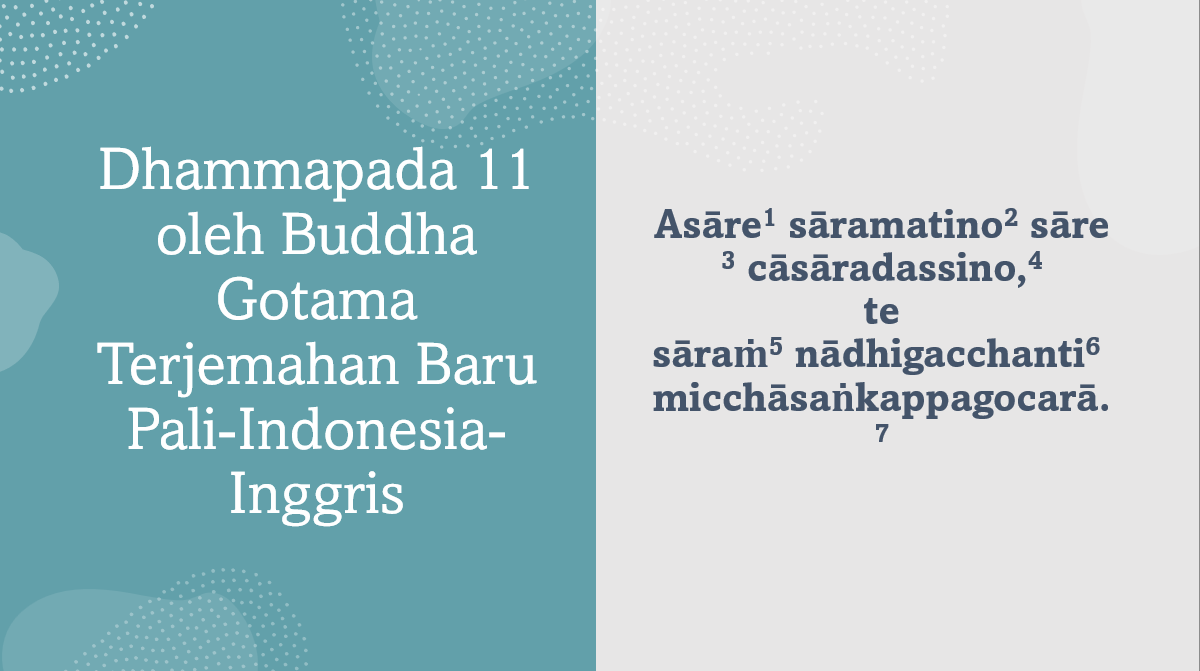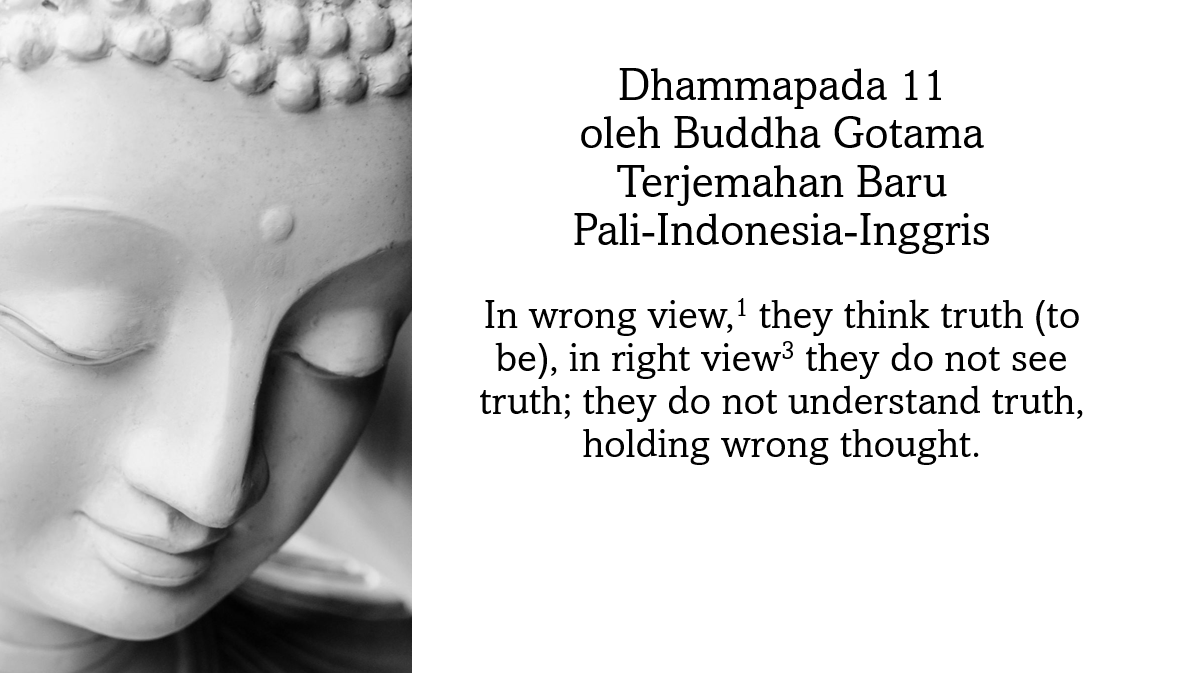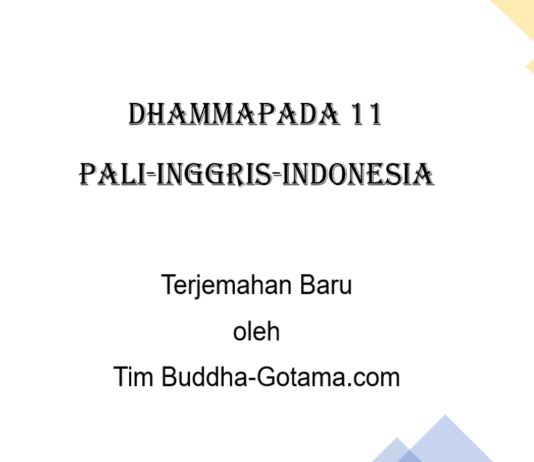Yamaka Vagga



Vocabulary 1 |
Vocabulary 2 |
asāre: in falsehoodsāramatino: (those who are) seeing truth or essencesāre: in truth, in essencecāsāradassino: (a) and (those who are) not seeing truth or essence; (b) euphonic union, or sandhi of, ca ‘and’ + āsāradassino ‘(those who are) not seeing truth or essence’te sāraṁ nādhigacchanti: they do not acquire, do not come into possession of, do not attain, (fig.) do not understand; |
nādhigacchanti: (a) (3rd. pers. pl. act. pres. indic.) do not acquire, do not attain, do not come into possession of , do not acquire, (fig.) do not understand; (b) euphonic union, or sandhi, of na ‘no, not;’ + adhigacchanti ‘to get to, to come into possession of, to acquire, (fig.) to understand;micchāsaṅkappagocarā: (pl. nom.) holding wrong thought; fig. having wrong thought as a pasture |
Grammar
1asāre: (a) lit., in what is not an essence (asāra); (b) according to the Commentary, (in) wrong view (asāra), i.e., untruth (Tin, 1993:5).
2sāramatino: (a) the plural form of the masculine noun saramatī ‘one who imagines finding the essence, which is also an adjective which means imagining finding the essence;’ (b) Geiger & Norman, 2005, § 83, p.76.5) write that sāramatino is a result of the mixing-up of –in and –ī inflections which has also led in the case of the –ī stems to the construction of forms according to the in declension.
Thus, aggino Saddh 585; dummatino Mhv 4.3 (with the analogous form mittadduno); sāramatino Dh.11; vajjamatino Dhp318 ….;
(c) Geiger & Norman (idem, § 95, pp. 87-88) further write:
The declension of substantives and adjectives ending in -in: Stem: hatthin ‘elephant’
(the sequence of cases has been reversed by the present author)
Singular plural
Singular Plural
Nom. hatthī, hatthi hatthī, hatthino
Gen. hatthissa, hatthino hatthinaṁ
Dat. hatthissa, hatthino hatthīnaṁ
Acc. hatthiṁ, hatthinaṁ hatthī, hatthino
Ins. hatthinā hatthīhi
Abl. hatthinā, hatthismā, hattimhā hatthīhi
Loc. hatthinī, hatthismiṁ, hatthimhi hatthīsu
Voc. hatthī hatthī, hatthino
(d)Duroiselle (1997:45, No.173) writes that there are some masculine nouns whose nominative singular ends in -ī. As a general rule, the masculine nouns of this class are adjectives used substantively; they properly belong to the consonantal declension, and their stems end in -in.
The plural nominative forms of these nouns take the suffix -no, as the those of dandī ‘merchant.’
singular plural
sāramatī (stem in) ‘(one) imagining truth’ sāramatino ‘(those) imagining truth’ (11)
asāradassī or āsāradassin ‘(one) not seeing truth’ asāradassino ‘(those) not seeing truth’ (11; cāsāradassino = ca + asāradassino ‘and/but those not seeing truth)
Declension of sāramatī following Duroiselle (idem., p.33, No.136):
Singular Plural
Nom. sāramatī sāramatī, sāramatino
Gen. sāramatissa, sāramatino sāramatinaṁ
Dat. sāramatissa, sāramatino sāramatinaṁ
Acc. sāramatiṁ, sāramatinaṁ sāramatī, sāramatino
Ins. sāramatinā sāramatīhi, sāramatībhi
Abl. sāramatinā, sāramatismā sāramatīhi, sāramatībhi
Loc. sāramatismiṁ, sāramatimhi sāramatīsu
Voc. sāramatī sāramatī, sāramatino
3sāre: (a) lit., in the essence; according to the Commentary, (in the) right view, i.e.,(in) truth (Tin, idem.); (b) the locative case of sāra ‘essence, right view, truth.’ See the declension table below.
The declension of sāra, a neuter noun, following Duroiselle (1915/1997:28, No.124)
singular plural
Nom. sāraṁ sārāni,(a) & (b) sārā
Gen. sārassa sārānaṁ
Dat. sārassa, sārāya* sārānaṁ
Acc. sāraṁ sārāni, sāre
Ins. sārena** sārehi, sārebhi
Abl. sārā sārehi, sārebhi
sārasmā***
sāramhā,*** sārato
Loc. sāre, sārasmiṁ*** sāresu
sāramhi***
Voc. sāra(-aṁ***) sārāni, sārā
Remarks:
(a) ni is essentially the distinctive sign of neuter nouns in the nom. acc., and voc. plur. in all declensions.
(b) The final vowel of the stem is lengthened before ni.
*sārāya: (1) Perniola (1997:325, No. 259) writes that in Pali only the thematic stems have a true dative case in -āya…. For the rest, Pali uses the genitive and it is under the genitive that are classified the examples which in other languages are considered as datives; (2) Muller, Edward (1884:67) writes that the old dative in -āya is only used to denote the intention, and is almost synonimous with an infinitive; only few instances occur where the dative has a terminating meaning as Dhp. v. 174, saggāya gacchati ‘goes to heaven,” and Dhp. v.311, nirayāya upkaddhati ‘brings to hell’….
(3) Duroiselle (ibid, p.26, No.122) writes that:
(a) The true Dat. sing. in āya has now generally been displaced by the suffix of the gen. ssa; the Dat. āya is almost equal to an lnfinitive and mostly denotes intention.
(c) so is sometimes used also as an Abl. sing. suffix: vaggaso, by groups, bhāgaso, by share.
(d) sā is also found as an Ins. sing. suffix, as: balasā, by force, forcibly, talasā, with the sole of the foot.
(e)Before ehi, ebhi, Ins. and Abl. plur. and e, Acc. plur. , the final a of the stem is dropped: dukkha + ehi = dukkh + ehi = dukkehi
(f)Before su, the Loc. plur., the final a of the stem is changed to e: dukkhesu.
**sārena: (a) by, with, because of truth, essence;’ (b) formed from sāra + -nā, with the elision of the final in sāra and the change of -nā to e (Kaccayana, idem, p. .., Thitzana trsl) ???
© Following Duroiselle (ibid, p. 8, No.21, & pp. 26-27, Nos. 120123), however, sārena would be derived from sāra + -ina in which the final a in sāra and the initial i in -ina combine to produce e.
Other examples of neuter nouns (Duroiselle, 1915/1997:28, No. 124):
citta, mind sota, ear
mūla, root, price veḷuriya, coral
upaṭṭhāna, service ahata, cloth (new)
jala, water osāna, end
loṇa, salt savana, hearing
vajira, diamond sāṭaka, garment
vāta, wind pesana, despatch, sending
yotta, rope paṭṭana, a seaport
yuddha, fight paṇṇa, leaf
Remarks:
(vii) It will be noticed that neuter nouns in a differ from the masculine in a, in the nom. and in the nom., acc. and voc. plur.; all the other cases are identical.
(b) In the plur. the nom. acc. and voc. have the same form.
(viii) The form in āni, of the , acc. and voc. plur. is the most common.
***-smā and -mhā, and -smiṁ and -mhi: (a) Mūller, Edward (1884:67-68) writes that in the ablative, the terminations -smā and -mhā, and in the locative, -smim and -mhi, are taken from the pronominal inflection. Besides, we have two other terminations for the ablative, to = skt. tas, and so = ças, which occur mostly in later texts, but also in a few instances in the Jataka and Dhp.v.320: cāpāto ‘from the bow’ ….; (b) Duroiselle (idem., pp. 26-27, No.122) writes that smā and mhā of the Abl. and smiṁ and mhi of the Loc. have been borrowed from the pronominal declension (see Declension of Pronouns); (c) The suffixes -asmā, -amhā, -ebhi, asmiṁ, and -amhi, and the singular vocative sāraṁ are alternate forms which are less common, or generally found in later or commentarial texts rather than in canonical texts (Gair & Karunatillake, 1998/2014:5).
4(i) This parses as ca + asāra + dassino; it is not clear to me why ca is found here, as it is not needed by the grammar, the meaning or the metre (Ānandajoti, www.ancient-buddhist-texts.net); (ii) cāsāradassino is ambiguous as it can be comprised of ca + either ᾱsara+dassino ‘seeing superficiality’ or a- + sᾱradassino ‘not seeing substance’ (Tjan)
5sāram: (i) essence, as in Dhammasāra ‘essence of the Dhamma (Davids & Stede 1923:175); (ii)Truth- According to the Commentary, essence of the Dhamma. The essence of the Dhamma comprises sīla (moral precepts or morality), samādhi (concentation), pañña (knowledge), vimutti (liberation), vimutti-ñaṇadassana (Knowledge of Insight into liberation), paramattha (ultimate truth), and Nibbāna (Tin, 2003:5).
6nādhigacchanti: (a) (3rd. pers. pl. act. pres. indic.) do not acquire, do not attain, do not get to, do not come into possession of, (fig.) do not understand; (b) derived from na ‘no, not’ + adhigacchanti (3rd pl. act. pres. indic.) acquire, attain, get to, come into possession of, (fig.) understand; (c) adhigacchanti: derived from adhi-* (verbal pf.) ‘over, above, on, upon, at, to, in, superior to, great, towards’ + √gachha** ‘to go’ + -nti (a verbal suffix to indicate 3rd. pl. act. pres.indic.)
*(a) Other examples of the usage of the prefix adhi-: adhi- + √vas ‘to live = adhivas ‘to live in, to inhabit;’ adhi- + √bhās ‘to speak = ‘adhibhās’ to speak to, to address; (b) the prefix adhi becomes ajjh before a vowel (Duroiselle, 1915/1997:119, No. 516): adhi-+ agaṁ ‘to go’ = ajjhagaṁ ‘ (I) approach;’ © agaṁ is an example of the radical aorist.
Duroiselle (idem., p.94, Nos. 409-410) writes that this aorist is not very common. We will give a few examples. Let it be first remarked that the aorist may also take the augment a before it, as the does the imperfect.
4.10 from √gam, and √ga and √gu (subsidiary forms of √gam) ‘to go,’ we have:
(a) Sing. Plur.
- agaṁ, agamā, agamiṁ agumha
- agā, agamā aguttha
- agā, agami aguṁ, agamixsu
(b) √as, to be (with augment a):
Sing. Plur.
- āsiṁ āsimha
- āsi āsittha
- āsi āsuṁ, āsiṁsu
4.11 √ṭhā
Sing. Plur.
- aṭṭhaṁ aṭṭhamha
- aṭṭho aṭṭhattha
3. aṭṭha aṭṭhaṁsu, aṭṭhuṁ
Remarks: For the doubling of initial ṭh, see 33.
4.12 From √kar we find: akaṁ (1st singular), no doubt formed on the analogy of: akā (1st, 2nd and 3rd singular); akā being itself from the Vedic form: akar, the loss of the r is compensated by the lengthening of the final a.
In the 1st singular, we also have: akaraṁ, akariṁ.
In the plural: 2. akattha; 3. akaruṁ, akarū, akariṁsu
4.13 √hū (a form of √bhū) to be.
3rd singular: ahū, ahu, and before a vowel, ahud. 1st plural: ahumhā; 3rd plural: ahuṁ.
4.14 √da
1st singular: adā, which is also 2nd and 3rd singular. In the plural we find: 3rd aduṁ, adaṁsu, adāsuṁ.
4.15 The augment a is not inseparable from the Aorist, so that we meet with such forms as: gā=agā, etc.
**√gachha belongs to the irregular bases of the seventh conjugation, as written by Duroiselle (idem, p.93, No. 404):
404. The roots of the seventh conjugation, as has been remarked above (379), have two bases: one in e and one in aya, which are conjugated exactly like the roots of the third class of the first conjugation (see 393).
Irregular Bases
Some roots form their special bases according to none of the above given rules, and they are in consequence called Irregular.
The principal forms are here given:
Roots Special bases
√gam, to go gaccha
√yam, to restrain yaccha
√guh, to hide gūhe
√dhā, to hold daha, dhe (391)
√dā, to give dajja
√jā, jan, to be born jāya
√pā, to drink piva
√ḍaṁs, to bite ḍasa
√dhmā, to blow dhama
√vyadh (=vadh) vadha
√sad, to sit sīda
√ṭhā, to stand tiṭṭhā
√is, to wish iccha
√vad, to speak, say vajja, vajje, vada, vāde
√mar, to die miya, miyya, mara
√gah to take, seize gheppa*
√gam, to go ghamma, gaggha*
√jir, to grow old, decay jiya, jiyya
√dis, das to see dakkha, daccha*
*These forms are given by the Saddanīti and the Akhyatapadamālā. They are regularly conjugated like gaccha: ghammāmi, ghammasi ghammati, etc.; ghagghami, ghagghasi ghagghati, etc.; ghammeyya, gagghe, gaggheyya, etc. The bases dakkha and daccha from √da, dis are formed on the false analogy of the future base, which we shall see when treating of the future. Most of the changes noticed above correspond to similar changes which occur in the 1st, 4th and 6th Conjugations of Sanskrit verbs.
7micchāsaṅkappagocarā: (a)(1) (pl. 3rd. pers. nom.) holding wrong thoughts, fig. having wrong thought as a sphere or pasture; (2) the fig. meaning is derived from the analogy of the construction (i) X-pakata ‘done or made out of X, (ii) X-ja ‘be born of X, (iii) X-nidāna ‘having X as the source of origin,’ (iv) X-vipāka ‘having X as result or fruit,’ (v) X-samudaya ‘having X as the origin, or arising from X, or the origin of X’ (Gair & Karunatillake, 2014:28), but (vi) X-gamin (fem. gaminī) ‘leading to X, going to X,’ (vii) x-jāta ‘having become X’ (idem, p.160), (viii) X-deva ‘having X as god, highly respecting X’ (idem., p.161); (ix) (Davids & Stede (1924:32, Part III) kamāvacara ‘having its province in kāma’
(b) euphonic union, or sandhi, of micchā (3rd. pers. pl. adjective) ‘wrong, erroneous’ + saṅkappa (masc.) ‘thought’ + gocarā ‘(those who are) wandering, roaming, (those cows which are) grazing;’ © gocarā is derived from go (masc.) ‘cow” + carā (pl. adj. and agent noun or doer*) ‘(those who are) walking, wandering, roaming, (lit. those cows which are) grazing’ (action noun) ‘destination, or place, of wandering or roaming or walking, pasture, grazing field, a cow’s grazing,;’ (d) gocarā is 3rd. pl. nom. and adj. of gocara (3rd person. sg. nom. and adj.) ‘(one who is) walking, roaming, wandering, (lit. that cow which is) grazing, roaming.
*Duroiselle (1915/1997:141-142, Nos.576-578) writes:
(i) Primary Derivatives (kita)
575. As has been said already Primary Derivatives are formed directly from the roots by means of certain suffixes; these suffixes are called kita suffixes.
576. The kita suffixes are given below in alphabetical order to facilitate reference.
a- (a) (ṇ) (a). By means of this suffix are formed an extremely large number of derivatives, some of which take guṇa and some of which do not. It forms nouns, (substantive and adjective) showing:
1st-action: √pac, to cook+a=pāka, the act of cooking; √caj, to forsake+a=cāga, forsaking, abandonment; √bhaj, to divide+a=bhāga, dividing; √kam, to love+a=kāma, love.
2nd- the doer or agent: √car, to roam+a=cāra and cara, a spy; √har, to take, captivate,+a=hara, the Captivator, a name of Shiva; √kar, to do, make+a=kara, that which does, the hand; also kāra, a doer, maker.
3rd- abstract nouns of action: √kar+a=kara, action, making; √kam to step, proceed+a=kama, step, succession, order; √kamp, to shake+a=kampa, shaking, trembling; √yuj, to join+a=yoga, joining.
4th- It forms adjectives: √kar+a=kāra, doing, making, also kara, causing, making; √car, to walk, roam, cāra, walking, roaming, and also cara, do; √plu, to swim, float+a=plava, swimming, floating.
The student will readily understand that the root may be preceded by any prefix: saṁ+√gam+a=saṅgāma, assembly; pa+√vis, to enter+a=pavesa, entrance; anu+√sar to go, move, walk+a=anusara, following. The same remark applies to all the other suffixes.
577. From the adjectives formed by this suffix (4th), are formed the upapada compounds (552): kammakāro=kammaṁ kāro (kammaṁ karotī’ ti), the doer of the act; kumbhakāro=khumbhaṁ kāro (kumbhaṁ karotī’ti), the maker of the pot, potter.
578. Very similar in nature with the upapada compounds are those compounds which are the names of persons. In our opinion they are purely and simply upapadas, but Kacchāyana has the following rule: “saññāyaṁ a nu” that is, to form a proper name, suffix nu (=ṁ=Accus. case) is added to the 1st member of the compound, which is the direct object of the root which forms the 2nd member and after which the suffix a is added to denote the agent: arindama, the subduer of his enemies=ari, enemy+ṁ (nu)+√dam, to subdue+a. So vessantara, who has crossed over to the merchants, (vessa+ṁ (nu)+√tar, to cross+a); taṇhaṅkara, creating desire=tanhā, desire+ṁ (nu)+kar+a. The name of a Buddha.
It will be seen from the above examples that the 1st member is in the Acc. case and is governed by the 2nd member which is an agent-noun formed by the suffix a.
Remarks: The nouns formed by a are masculine: they form the feminine according to rules (183), and the same applies to the adjectives (197).
|
English 1: |
English 2: |
|
Those who consider the non-essential as the essential, |
They who imagine truth in untuth, and see untuth in truth, never arrive at truth, but follow vain desires. |
|
Indonesia 1: |
Indonesia 2: |
|
Barangsiapa menganggap sesuatu yang tak hakiki sebagai hakiki, dan sebaliknya menganggap tak hakiki sesuatu yang hakiki, mereka yang terpacak pada pikiran keliru semacam ini tidak akan memperoleh apa yang hakiki. |
Mereka yang menganggap (sebagai) hakiki pada sesuatu yang bukan hakiki, dan mereka yang melihat (sebagai) bukan hakiki pada sesuatu yang hakiki. Mereka yang bersekutu dengan pikiran keliru (seperti itu) tidak akan memahami sesuatu yang hakiki. |



